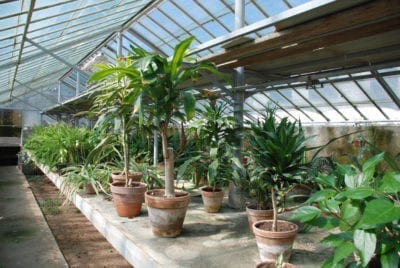
Growing plants in a greenhouse offers many advantages such as earlier seed start times, bigger yields, and a longer growing season. The simple effect of an enclosed garden space combined with focused sunlight creates an ideal growing site. However, humidity can often be an enemy in such conditions. Condensation is a common by-product of moisture, close confines, and high temperatures, especially where the exterior of the greenhouse is buffeted by cold temps.
Humidity in a greenhouse is important but managing it is
crucial to preventing fungal and other issues. Learn how to reduce greenhouse
humidity when necessary to prevent common plant problems.
Greenhouse Humidity Info
Is greenhouse humidity important? Well, depending on what
you are growing in your greenhouse, humidity may be necessary or just a common
effect. Some plants, like most tropical specimens, need humidity. Other plants,
such as many succulents,
will develop rots and mildews that can kill them. It is important to keep a
careful balance of the amount of ambient moisture for each type of plant.
Why reduce greenhouse humidity? Spring and fall are when
humidity levels rise the most in greenhouses. Sunlight increases evaporation
and plant transpiration, which is held as vapor inside the structure. At night,
cooler temperatures cause condensation which may form as droplets on leaves.
Some plants love the increased moisture in the air, but it is a common cause of
fungal disease.
This is when managing humidity is most important. Humidity
in a greenhouse promotes such diseases as botrytis
blight and powdery
mildew.
How to Reduce Greenhouse Humidity
Air circulation is crucial to managing ambient moisture. You can increase this by means of vents, fans, and plant spacing. With suitable ventilation, you can replace the moist interior air with cooler, dryer exterior air.
During the night, reduce the temperature of heaters to
prevent the condensation that forms from the extreme temperature ranges of cold
outside and warm inside.
Fans or blowers are effective in houses without vents. Often,
these are used on timers and work in conjunction with a heater to move air and
keep temperatures consistent. Using a humidistat can help manage air moisture
and keep it at optimal levels.
One of the simplest ways to prevent excess humidity is by avoiding standing water in the greenhouse. Puddles, water in saucers, or in trays will evaporate and form droplets. Using drip irrigation will help direct water only to roots, avoiding excess moisture. It also prevents plant leaves from remaining wet where fungal pathogens can breed.
Plant spacing, well-draining floors, and slatted benches are other ways to minimize humidity. Watering early enough in the day for excess moisture to evaporate can also help control the problem.
Bottom heat is effective as well, as the warm air rises and creates air movement. These are inexpensive ways to manage humidity and in most cases will provide adequate control.
Growing plants in a greenhouse offers many advantages such as earlier seed start times, bigger yields, and a longer growing season. The simple effect of an enclosed garden space combined with focused sunlight creates an ideal growing site. However, humidity can often be an enemy in such conditions. Condensation is a common by-product of moisture, close confines, and high temperatures, especially where the exterior of the greenhouse is buffeted by cold temps.
Humidity in a greenhouse is important but managing it is
crucial to preventing fungal and other issues. Learn how to reduce greenhouse
humidity when necessary to prevent common plant problems.
Greenhouse Humidity Info
Is greenhouse humidity important? Well, depending on what
you are growing in your greenhouse, humidity may be necessary or just a common
effect. Some plants, like most tropical specimens, need humidity. Other plants,
such as many succulents,
will develop rots and mildews that can kill them. It is important to keep a
careful balance of the amount of ambient moisture for each type of plant.
Why reduce greenhouse humidity? Spring and fall are when
humidity levels rise the most in greenhouses. Sunlight increases evaporation
and plant transpiration, which is held as vapor inside the structure. At night,
cooler temperatures cause condensation which may form as droplets on leaves.
Some plants love the increased moisture in the air, but it is a common cause of
fungal disease.
This is when managing humidity is most important. Humidity
in a greenhouse promotes such diseases as botrytis
blight and powdery
mildew.
How to Reduce Greenhouse Humidity
Air circulation is crucial to managing ambient moisture. You can increase this by means of vents, fans, and plant spacing. With suitable ventilation, you can replace the moist interior air with cooler, dryer exterior air.
During the night, reduce the temperature of heaters to
prevent the condensation that forms from the extreme temperature ranges of cold
outside and warm inside.
Fans or blowers are effective in houses without vents. Often,
these are used on timers and work in conjunction with a heater to move air and
keep temperatures consistent. Using a humidistat can help manage air moisture
and keep it at optimal levels.
One of the simplest ways to prevent excess humidity is by avoiding standing water in the greenhouse. Puddles, water in saucers, or in trays will evaporate and form droplets. Using drip irrigation will help direct water only to roots, avoiding excess moisture. It also prevents plant leaves from remaining wet where fungal pathogens can breed.
Plant spacing, well-draining floors, and slatted benches are other ways to minimize humidity. Watering early enough in the day for excess moisture to evaporate can also help control the problem.
Bottom heat is effective as well, as the warm air rises and creates air movement. These are inexpensive ways to manage humidity and in most cases will provide adequate control.
